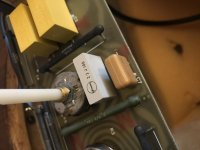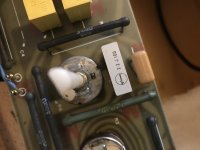Morning all.
You’ll probably confirm that I do have a screw lose when you read this .
I have my Tannoy SRM12x speakers that I recapped back in January with equal value Ansar supersound capacitors , and gave them 3 months of daily usage to burn in but I was never happy with the sq so 2 weeks ago I put all the old capacitors back in and hey presto the magic was back , some had strayed from 6.8uf to 7.1uf ( I tested them all when I initially removed them ) . So I now have all 8 identical nos caps on their way to me ( they’re Philips) but I need to get 2 identical ones seen in the picture, there is no brand name on them , they measure 27mm x 8 or 9 mm and have 2.2 J 100 printed on them ( and the little wave thing )
Anyone know this brand ?
Ps : I am fully aware that I can replace them with similar ones .
You’ll probably confirm that I do have a screw lose when you read this .
I have my Tannoy SRM12x speakers that I recapped back in January with equal value Ansar supersound capacitors , and gave them 3 months of daily usage to burn in but I was never happy with the sq so 2 weeks ago I put all the old capacitors back in and hey presto the magic was back , some had strayed from 6.8uf to 7.1uf ( I tested them all when I initially removed them ) . So I now have all 8 identical nos caps on their way to me ( they’re Philips) but I need to get 2 identical ones seen in the picture, there is no brand name on them , they measure 27mm x 8 or 9 mm and have 2.2 J 100 printed on them ( and the little wave thing )
Anyone know this brand ?
Ps : I am fully aware that I can replace them with similar ones .
Attachments
It's a film type capacitor made by Plessey. By the markings its probably a 2.2uf 100v capacitor.
btw, film capacitors don't stray in value but will vary because of tolerance in manufacturing and are typically available in 5%, 10% and 20% tolerance values, so a 6.8uf capacitor that measures 7.1uf is actually within tolerance (+-10%).
btw, film capacitors don't stray in value but will vary because of tolerance in manufacturing and are typically available in 5%, 10% and 20% tolerance values, so a 6.8uf capacitor that measures 7.1uf is actually within tolerance (+-10%).
Last edited:
J stands for +/- 5 %, so it is 2.2 uF +/- 5 %, 100 V. The 6.8 uF capacitors are indeed 6.8 uF +/- 10 %, 100 V.
Thanks for your input. Someone else also confirmed what you have said. Thanks
And don´t expect much "burn in" variation in film caps (or resistors, or semiconductors):
The concept is valid for *mechanical* parts, such as speakers, because edge and suspension change properties a lot when moving back and forth, they lose stiffness, change elasticity, lower Q, become smoother, etc.
Same way as new shoes adapting to your feet, books staying open on most read pages, guitar strings stretching and varying tuning, etc.
But a film cap dielectric is *incredibly* stable in its properties and normal use is not stressing it at all.
The concept is valid for *mechanical* parts, such as speakers, because edge and suspension change properties a lot when moving back and forth, they lose stiffness, change elasticity, lower Q, become smoother, etc.
Same way as new shoes adapting to your feet, books staying open on most read pages, guitar strings stretching and varying tuning, etc.
But a film cap dielectric is *incredibly* stable in its properties and normal use is not stressing it at all.
And don´t expect much "burn in" variation in film caps (or resistors, or semiconductors):
The concept is valid for *mechanical* parts, such as speakers, because edge and suspension change properties a lot when moving back and forth, they lose stiffness, change elasticity, lower Q, become smoother, etc.
Same way as new shoes adapting to your feet, books staying open on most read pages, guitar strings stretching and varying tuning, etc.
But a film cap dielectric is *incredibly* stable in its properties and normal use is not stressing it at all.
So that must surely apply to cabling? Just bought some duelund cable for interconnects and speaker cable and the website states 100hrs burn in for the interconnects. Personally I can’t see how it would possibly make any difference.
Thanks for your input.
Yellow are maybe MKC from Philips and the white MKT (Plevey so), size of the pot makes me think about that.
Why did you recape if already film caps ? they last a life... Better is to solder back the one you have if you keeped after a carreful measurement. Philips is more or less BC component... while not sure they are exactly the same, I found subjective changes at ears between MKT of small size... it may also be bias...
The only problem with desoldering & resoldering a film cap may affect it due to the temperature.
MKC are hard to find these days, try Ebay with old Wima NOS or russia. For the white if really a MKT, you have excellent K73-16 ( 5% 100 Vdc exist) and are often in the 2 to 3% range when you measure. Cheap and good sounding too, not squarred casing though.
Why did you recape if already film caps ? they last a life... Better is to solder back the one you have if you keeped after a carreful measurement. Philips is more or less BC component... while not sure they are exactly the same, I found subjective changes at ears between MKT of small size... it may also be bias...
The only problem with desoldering & resoldering a film cap may affect it due to the temperature.
MKC are hard to find these days, try Ebay with old Wima NOS or russia. For the white if really a MKT, you have excellent K73-16 ( 5% 100 Vdc exist) and are often in the 2 to 3% range when you measure. Cheap and good sounding too, not squarred casing though.
Its marketing BS, cables do not need burn in, in fact almost nothing electronic needs burn-in, although it is true that a period of soak-testing can catch prematureSo that must surely apply to cabling? Just bought some duelund cable for interconnects and speaker cable and the website states 100hrs burn in for the interconnects. Personally I can’t see how it would possibly make any difference.
Thanks for your input.
failures (the infamous bathtub-curve), but that's something the manufacturer could do for you if premature failures are possible with the component in question.
The best speaker cable is the cheapest copper cable of suitable cross-sectional area (depends on the length of run, longer runs may require thicker copper to keep cable resistance in check). Money wasted on expensive speaker cable could have gone to improving room acoustics, normally the limiting factor
Electrons don't get tired, or need warming up before use!
Its marketing BS, cables do not need burn in, in fact almost nothing electronic needs burn-in, although it is true that a period of soak-testing can catch premature
failures (the infamous bathtub-curve), but that's something the manufacturer could do for you if premature failures are possible with the component in question.
The best speaker cable is the cheapest copper cable of suitable cross-sectional area (depends on the length of run, longer runs may require thicker copper to keep cable resistance in check). Money wasted on expensive speaker cable could have gone to improving room acoustics, normally the limiting factor
Or in a better pair of acoustic cabinets.
I consider that investment more profitable before the acoustic treatment of the room.
The best acoustic treatment will not give great sound to poor quality cabinets.
But, good cabinets will sound great in a poor room with only a few fixtures in it.
In general, these are very efficient.
Do not block the radiation of the speakers with any bulky object in front of them.
Furniture should be a mix of absorbent and refractory surfaces. Carpets and curtains in the first case, rigid surfaces such as glass frames, porcelain, etc., in the second.
The quantity, location and proportion between these surfaces / objects will depend on the dimensions and shape of the listening room, location of the speakers, etc., but it is not necessary to invest in sound traps or special acoustic coatings in the vast majority of cases.
Judiciously tuning a simple tone control (greatly underestimated by purists) can do much more than all of these artifacts.
In short, it is about not allowing the waves generated by the speaker to return to it creating undesirable harmonics and resonances.
Electrons don't get tired, or need warming up before use!
Or in a better pair of acoustic cabinets.
I consider that investment more profitable before the acoustic treatment of the room.
The best acoustic treatment will not give great sound to poor quality cabinets.
But, good cabinets will sound great in a poor room with only a few fixtures in it.
In general, these are very efficient.
Do not block the radiation of the speakers with any bulky object in front of them.
Furniture should be a mix of absorbent and refractory surfaces. Carpets and curtains in the first case, rigid surfaces such as glass frames, porcelain, etc., in the second.
The quantity, location and proportion between these surfaces / objects will depend on the dimensions and shape of the listening room, location of the speakers, etc., but it is not necessary to invest in sound traps or special acoustic coatings in the vast majority of cases.
Judiciously tuning a simple tone control (greatly underestimated by purists) can do much more than all of these artifacts.
In short, it is about not allowing the waves generated by the speaker to return to it creating undesirable harmonics and resonances.
Food for thought.Lowering noise in audio but does it?... YouTube
This matters in high impedance circuits only, such as valve circuitry, most transistor / opamp circuits are too low an impedance to care about a pF or so of extra parasitic coupling, which is many megohms equivalent at 20kHz and even higher at lower audio frequencies.
- Status
- This old topic is closed. If you want to reopen this topic, contact a moderator using the "Report Post" button.
- Home
- Design & Build
- Parts
- Capacitor identification please


